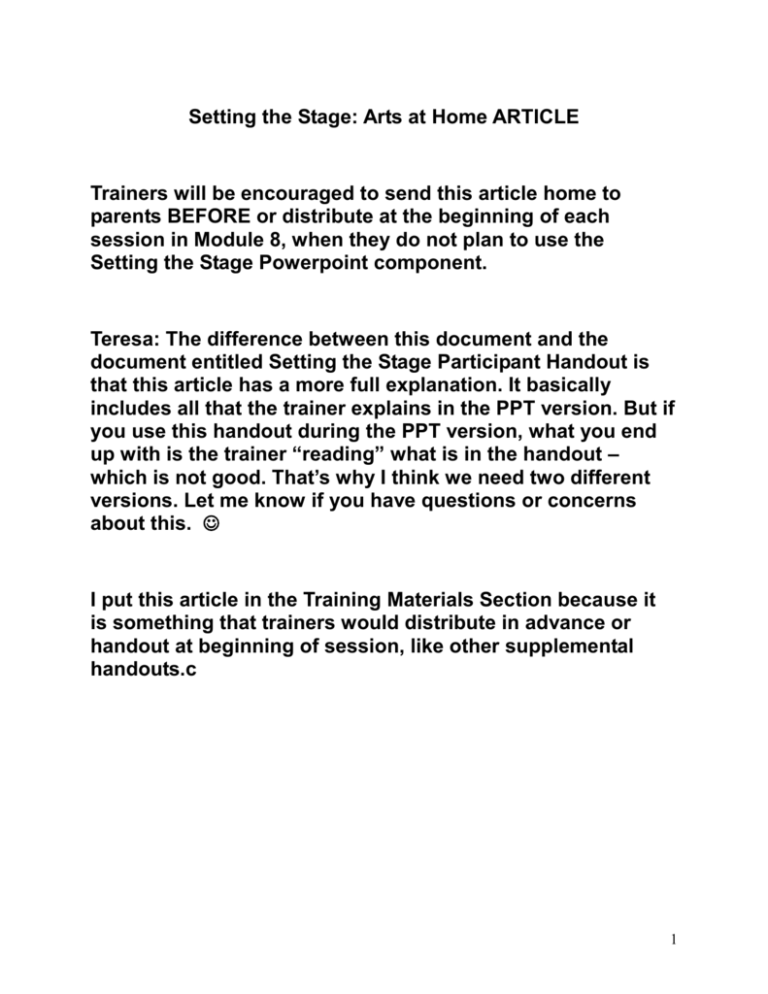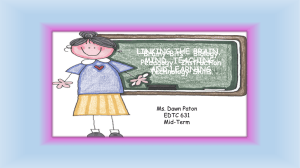The Power of the Arts
advertisement

Setting the Stage: Arts at Home ARTICLE Trainers will be encouraged to send this article home to parents BEFORE or distribute at the beginning of each session in Module 8, when they do not plan to use the Setting the Stage Powerpoint component. Teresa: The difference between this document and the document entitled Setting the Stage Participant Handout is that this article has a more full explanation. It basically includes all that the trainer explains in the PPT version. But if you use this handout during the PPT version, what you end up with is the trainer “reading” what is in the handout – which is not good. That’s why I think we need two different versions. Let me know if you have questions or concerns about this. I put this article in the Training Materials Section because it is something that trainers would distribute in advance or handout at beginning of session, like other supplemental handouts.c 1 Setting the Stage: The Arts at Home The Arts When people hear the phrase “the arts,” they typically think of the visual arts – things like drawing and painting and sculpting. But when referred to collectively, “the arts” also include the art forms of music, drama, literature, and dance. Much of children’s creative play involves the various forms of art. For example, children engage in: Music when they sing songs and experiment with sound-making with common household items (e.g., beating on pots and pans) Dance when they move with joy and abandon to the sound of music Visual Arts when they draw, paint, and make things with play-dough and other objects Literature when they listen to stories, tell stories, and play with rhyming words Drama when they use puppets, act out a story, play dress-up, or pretend to be an animal, mommy, daddy, firefighter Think about the arts in your life… As a child: Did you play make-believe or dress-up, draw pictures or sing songs? Did you think of these activities as the “arts” - or just as fun? Did you take music, drama, or dance lessons? Did your parents or other adults ever do any of these activities with you? How did that make you feel? As an adult: Do you go to plays, movies, concerts, or dance performances? What are your favorite books? Do you have any hobbies that involve artistic skills such as painting, quilting, decorating your home, arranging flowers, or photography? Do you play an instrument or sing (in church, the car, or the shower)? Do you think of yourself as creative? Quote to use somewhere in this handout… When we teach a child to draw, we teach him how to see. When we teach a child to play a musical instrument, we teach her how to listen. When we teach a child how to dance, we teach him how to move through life with grace. When we teach a child to read or write, we teach her how to think. When we nurture imagination, we create a better world, one child at a time. Jane Alexander, chair for the National Endowment for the Arts, Imagine! (1997) (cited in Cornett, 1999, p. 79) 2 The Power of the Arts Both neuroscience and academic research now offers compelling evidence, making the case that the arts are not only important, but a necessary ingredient (OR component) of a child’s life. When you (parents and teachers) engage and encourage children in arts activities (at home and in early childhood programs), beginning at birth, you are providing opportunities that: Wire the brain, connecting brain cells (neurons) Promote all areas of development: physical, social, emotional, and cognitive. For example, - Creative movement and dance promotes physical development of large muscles, body coordination and balance. - Drawing, painting, and sculpting with play dough promote decision-making and develop eye/hand coordination needed for writing. - Group music, dance, and drama activities develop social skills. - Looking at and describing visual art develops analytical thinking skills. - Stories, poems, and songs help children learn about feelings. Dance, drama, music, and visual arts offer opportunities to express feelings. - Acting out a story, pretending to be something, or move like something stimulates imagination. Lay the foundation for academic achievement by developing skills needed for literacy and math. For example: - Reading to children and dramatic enactment (children acting out stories) develops literacy skills (e.g.,vocabulary, phonological awareness, increased comprehension both oral and textual) - Learning how to play the piano/keyboard develops spatial-temporal reasoning which is needed to understand math concepts Help children learn about and appreciate their own cultural heritage and that of others Provide a lifetime of joy of the artistic expression, theirs and others in a variety of means and experiences.??or something about joy and aesthetics – artistic expression – the whole idea of arts for arts sake Develop thinking skills and other characteristics needed for successful careers (e.g., reasoning and creativity; ability to communicate, use imagination, and problem solve). In other words, the arts offer young children benefits that last a lifetime. And that is the power of the arts. QUOTE (see below) A close look at what constitutes the best kind of experience for infants and young children leads quickly to the arts. From a baby’s first lullaby, to a three-year-old’s experimentation with finger paint, to a seven-year-old’s dramatization of a favorite story, developmentally appropriate arts experience is critical. For all children, at all ability levels, the arts play a central role in cognitive, motor, language, and social-emotional development. The arts motivate and engage children in learning, stimulate memory and facilitate understanding, enhance symbolic communication, promote relationships, and provide an avenue for building competence. The arts are natural for young children. Child development specialists note that play is the business of young children; play is the way children promote and enhance their development. The arts are a most natural vehicle for play. 3 Arts Education Partnership’s report, Young Children and the Arts (1998, p. v.) Structures of the Brain To fully understand the power of the arts, it helps to understand how the arts stimulate brain development (OR increase your child’s capacity to learn). Different areas of your child’s brain have different functions. For example:1 Movement is coordinated in the cerebellum. Visual data is processed in the occipital lobes (vision). Auditory data is processed in the temporal lobes (hearing). Touch and sensation information such as heat, cold, pressure, and pain are processed in the parietal lobes. Higher level thinking such as critical thinking, reasoning, making decisions, and exercising judgment all take place in the frontal lobes. Touch & Sensation (Parietal Lobe) Thinking (Frontal Lobe) Vision (Occipital Lobe) Movement (Cerebellum) Hearing (Temporal Lobe) 1 This is a partial listing of the many functions of each brain area. For more information about the brain, see references and recommended resources at the end of this handout. 4 The Arts “Wire” the Brain Your child’s brain will use networks of connected neurons (brain cells) to send signals to and from these various areas and to other parts of his/her body. However, although your child is born with a lot of neurons, more than 100 billion, most are not yet connected. Think of a phone system with a lot of phones that are not connected to each other. The experiences your child has during the first five years of life influence the way the neurons in his/her brain will be connected or “wired” together. As Pam Schiller said, “Experience is the architect of the brain” (2001, p. 15). Every time your child uses his/her senses – when he/she touches, hears, sees, tastes or smells something, a message is sent to the brain and connections are made between some neurons in different parts of the brain. Because the arts involve multiple senses, the arts really stimulate the “wiring” process. As your child plays with play dough, draws and paints, sings, dances to music, or acts out his/her favorite story, neurons are busy connecting. More connections increase the brain’s ability to take in, process and make sense of information (Stephens, 1999). Think of neural network connections as a path in the woods. “The first time you create a path, it is rough and overgrown. The next time you use it [the path], it is easier to travel because you have previously walked over the weeds and moved the obstacles” (Sprenger, 1999). From that point on, every time you walk the path it gets smoother and becomes easier to travel. In the same way, the more specific neural networks are used, the stronger and more efficient they become, increasing your child’s capacity to learn. Over time, repeated experiences will create a circuitry system that your child’s brain will also use to read books, calculate math, solve problems and do other types of thinking that academic and future success requires. QUOTE (see below) “Newly formed neurons establish connections with each other that continue to increase on the basis of experience. With each new experience new connections are formed. Change the experience, and you change the brain (Restak, 2002).” 5 References Cornett, C. (1999). The arts as meaning makers: Integrating literature and the arts throughout the curriculum. Upper Saddle River, NJ: Prentice-Hall, Inc. Restak, R. (2002). The remarkable plasticity of the brain. Retrieved on July 20, 2007 from www.pbs.org/wnet/brain/pdf/brainadultguide.pdf. Schiller, P. (2001, July). Brain research and its implications for early childhood programs. Child Care Information Exchange, 140, 14-18. Sprenger, M. (1999). Learning and memory: The brain in action. Alexandria, VA: Association for Supervision and Curriculum Development (ASCD). Stephens, K. (1999, March). Primed for learning: The young child’s mind. Child Care Information Exchange, 126, 44-48. Recommended Resources To learn more about how your child’s brain develops and what you can do to enrich your child’s development, check out the following websites and resources: - Zero to Three’s Baby Brain Map. (www.zerotothree.org/site/PageServer?pagename=ter_util_babybrainflash). - A Day in the Life of the Brain (www.brainconnection.com/BAW/?main=day/home) - Secret Life of the Brain (www.pbs.org/wnet/brain) - The Brain from Top to Bottom (http://thebrain.mcgill.ca) - Eliot, L. (1999). What’s going on in there? How the brain and mind develop in the first five years of life. New York, NY: Bantam Books. - Jensen, E. (2001). Arts with the brain in mind. Alexandria, VA: Association for Supervision and Curriculum Development. To learn more about how the arts can benefit your child, check out these documents: - Arts Education Partnership (1998). Young children and the arts: Making creative connections – A report of the Task Force on Children’s Learning and the Arts: Birth to Age Eight. Washington, DC: Author. Retrieved on March 24, 2007 from www.aep-arts.org/files/publications/Young%20Children.pdf. - Arts Education Partnership. (2002). Critical links: Learning in the arts and student social and academic development. Retrieved on July 22, 2007 from http://www.aeparts.org/files/publications/Critical%20Evidence.pdf. - Murfee, E. (1995). Eloquent evidence: Arts at the core of learning. Retrieved on March 1, 2007 from http://www.nasaa-arts.org/publications/eloquent.pdf. - National Assembly of State Arts Agencies. (2006). Critical Evidence: How the Arts Benefit Student Achievement. Retrieved on March 22, 2007 from www.nasaa-arts.org/publications/critical-evidence.pdf. - National Endowment for the Arts. (2004). Imagine! Introducing your child to the arts. Retrieved on March 22, 2007 from www.nea.gov/pub/imagine.pdf. - Zero to Three. (2000). Starting smart: How early experiences affect brain development. Retrieved on September 30, 2007 from www.zerotothree.org/site/DocServer/startingsmart.pdf. 6





